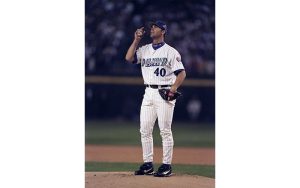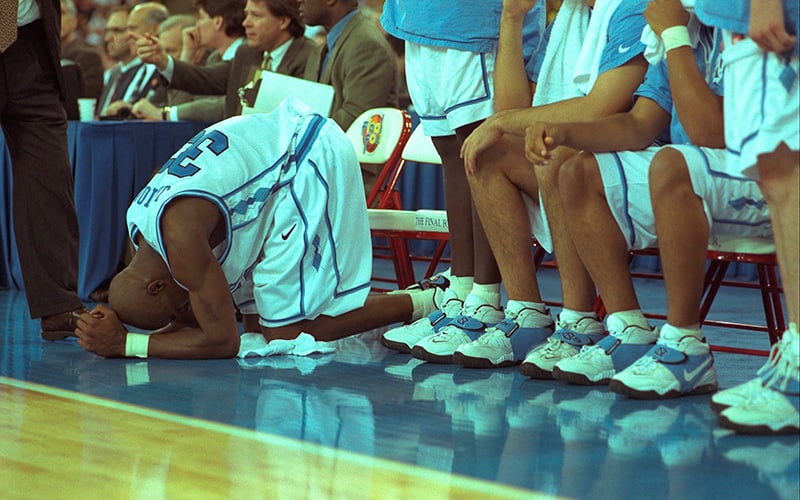With the sports world on hold, Cronkite News will take a daily look at this day in sports history and reflect on some of the biggest moments in Arizona sports.
PHOENIX – With Bank One Ballpark’s novel retractable roof opened to reveal a clear and star-filled night sky, the Arizona Diamondbacks hosted the Colorado Rockies in the Arizona franchise’s inaugural game on March 31, 1998.
Wearing a purple cap and one of the team’s home white uniforms with purple pinstriping and “Diamondbacks” lettered in the team’s original purple and teal colors across the chest, manager Buck Showalter delivered his first lineup card to plate umpire Jim Quick.

Leading off, he penciled in speedy center fielder Devon White followed by shortstop Jay Bell, first baseman Travis Lee, third baseman Matt Williams, left fielder Brent Brede, right fielder Karim Garcia, catcher Jorge Fabregas, second baseman Edwin Diaz and starting pitcher Andy Benes.
With most of the 47,484 fans on their feet in anticipation, Benes delivered the first pitch in team history amid blinding flashes from a sea of disposable cameras glittering throughout the stands.
And with that, the long, tumultuous quest to bring Major League Baseball to Arizona was finally realized.
“First pitch was thrown by Andy Benes, a ball up high to Rockies second baseman Mike Lansing and we were underway,” said Greg Schulte, the Diamondbacks radio play-by-play broadcaster then and now, who was dressed in a tuxedo along with the rest of the team’s broadcast team.
The first pitch was one of many firsts for Benes, the 6-foot-6 right-hander who played two seasons for the Diamondbacks. He recorded the first out, first strikeout and gave up the first home run in that game. He also gave up the first hit when Lansing eventually reached on a single in that first inning.
“There’s only one first,” Benes said. “I had a lot of the firsts. They tell people I had the first ball, the first strike, first out, first hit given up, the first home run into the swimming pool. (I) had the first win, the first loss.”
But the first pitch is the one that is most vivid in his memory.
“I just remember, there was such a buzz with the first pitch, that I just remember going into my delivery,” Benes said. “Obviously I’m looking at the catcher’s glove, my target, but just to see all the cameras. I mean everybody there was taking a picture of some type. And I actually have a picture of that with all the flashes going off.
“When you’re going through it, initially, then you see a replay and you’re like, ‘Wow that was really, really cool.’
“But that day, and the time leading up to it, was just a real special time and a real celebration for Phoenix. They had baseball for a long time there, obviously, with spring training and Triple-A and all of that. But a major league team in that city, and the excitement, was something that I had never seen before. I’m really proud to be a part of that organization.”
Jerry Colangelo, who also was the managing partner of the Phoenix Suns at the time, led the ownership group that attained the franchise and spearheaded the effort to build Bank One Ballpark at 7th and Jefferson streets in downtown Phoenix.
Colangelo hired Showalter years before that 1998 debut to be the architect of the ballclub, along with General Manager Joe Garagiola Jr., the son of long-time baseball broadcaster and media personality Joe Garagiola. Showalter won 250 games as manager in Arizona, but the opener wasn’t one of them.
Colorado prevailed, 9-2, when Rockies third baseman Vinny Castillo slugged a two-run home run in the sixth inning off Benes and followed with a three-run shot in the seventh off of reliever Clint Sodowsky.
White went to the plate for the Diamondbacks in the bottom half of the first inning and struck out swinging against Rockies pitcher Darryl Kile as the first hitter in team history. Jay Bell followed by grounding out, then rookie first baseman Travis Lee delivered the club’s first hit, a first-pitch single up the middle.
Later in the game, Lee hit the franchise’s first home run and he remains the only major league player ever to hit a home run Opening Day for his first and last teams. He started his final season in Tampa with a homer on Opening Day in 2006.
Before Colangelo’s effort, several groups had tried and failed to obtain either an existing or expansion major league franchise for the Phoenix area.
And at about the same time, the future of spring training in Arizona was in question as teams sought new facilities and the Grapefruit League in Florida was maneuvering to lure Cactus League teams in Arizona there.
Garagiola Jr. said Arizona was in real danger of losing the Cactus League, and the push to build new ballparks and reverbish others to keep it sent a message to MLB.
“There was this great asset and it appears you’re in real jeopardy of losing it,” Garagiola said. “So, we’re kind of looking at this as, this is your moment. If you don’t step up and it goes away; well, that’s going to send us one message. If on the other hand, you do; well, that’s going to send a different message.
“With the help of then Governor Rose Mofford and Dwight Patterson, myself and some others, we began to get things done to solidify the Cactus League.”
Patterson was a Mesa businessman and philanthropist who helped lure the Chicago Cubs to Mesa in 1949, an effort that earned him the unofficial title “Father of Cactus League Baseball.”
Long before Benes unleashed that first pitch, Colangelo, Garagiola and Showalter had put everything in place, hiring scouts and player development staff, establishing a minor league system, organizing and executing two amateur drafts and an expansion draft and signing the free-agent Lee, the second player selected overall in the 1996 MLB Draft, to a controversial four-year, $10-million contract when the San Diego Padres drafted him but could not come to terms.

Pitcher Andy Benes started the Diamondbacks’ inaugural game as a franchise and is part of many firsts from that meeting with the Colorado Rockies. (Photo by Vincent Laforet/Getty Images)
“We picked the players who would be on the major league team,” Garagiola said. “And I knew going through it that these were all experiences that very few people get to have, just because there aren’t many expansion opportunities that come along, the Diamondbacks and the Devil Rays being a good example.
“Those franchises were awarded 25 years ago and there’s been no expansion since then. So, to have that opportunity, to really build a team from scratch, starting at zero, was just a terrific opportunity. And then, of course, all the success we had early on that was pretty great, too.”
The Diamondbacks lost that opener and 96 more games in their inaugural season, but the franchise won a World Series in their fourth season, beating the Yankees in a seven-game series.
“The Rockies won the game 9-2, but D-backs fans didn’t care,” said Schulte, who was on the call when Luis Gonzalez looped a bases-loaded dying flare off of the unhittable Mariano Rivera for that World Series victory against the Yankees.
“Heck, they stuck around to the end to watch the roof close. (The inaugural game) is still one of the most exciting moments, for me, in Diamondbacks history.”


